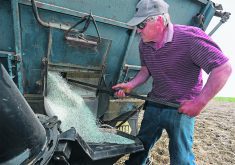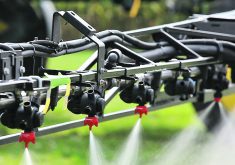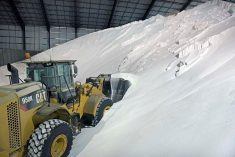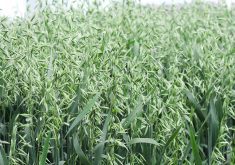CLANDEBOYE, Man. — Manitoba Agriculture data suggest that many crops will be profitable in 2023, assuming average yields. But there is a potential scenario where crop prices weaken and input costs remain high, says a farm management specialist with Manitoba Agriculture.
No one can predict the future, but producers should think about softer grain prices and persistently high prices for crop inputs, said Darren Bond.
“If that happens, what’s (the) plan going to be?” asked Bond, who spoke at a Manitoba Agriculture meeting held in early January in Clandeboye, north of Selkirk, Man.
Read Also

New coal mine proposal met with old concerns
A smaller version of the previously rejected Grassy Mountain coal mine project in Crowsnest Pass is back on the table, and the Livingstone Landowners Group continues to voice concerns about the environmental risks.
Every year, Manitoba Agriculture publishes a cost of production guide, one for crops and another for livestock. Bond shared data from the 2023 crop production report with a crowd of about 90 at the Clandeboye community hall.
The data shows that the financial risk of crop production has changed dramatically compared to a few years ago.
From about 2016-19, the costs of fertilizer, pesticides, fuel and other crop inputs were fairly stable. They were increasing, but at a steady rate.
Then input costs went through the roof.
“If we look at fertilizer (per acre) on canola in 2021, $88. (Then) up to $184 in 2023,” Bond said. “Pesticide has also doubled, or just over doubled. And fuel has also doubled.”
In 2018, the total cost (operating and fixed costs) of growing crops was around $300 to $500 per acre. Now, in 2023, it’s $500 to $800 per acre.
Crop prices are still strong and there’s an opportunity for growers to make money in 2023. But the math isn’t the same, Bond said.
“We had those $40 to $50 profits (per acre) and $400 production costs,” he said.
With average yields, similar profits can be had in 2023, but production costs are now about $700 per acre.
“In the past, we’ve only looked at profitability when we made our… cropping choices. Now we need to factor in this risk,” Bon said.
One way to manage the risk is a forward contract, to lock in a price for a portion of the farm’s production. But there are other ways, such as choosing crops with stable yields.
As an example, the cost of production guide said potential profits from soybeans and canola are similar, assuming average yields:
- With a yield of 44 bushels per acre and a price of $17 per bu., the estimated profitability of canola is $44.59 per acre.
- Assuming a yield of 36 bu. per acre and a price of $16 per bu., the profitability of soybeans is $35.33 per acre.
But that doesn’t tell the whole story. In certain regions of Manitoba, soybean yields can be highly variable, maybe 25 bu. one year and 45 bu. the next. In a year with extremely high input costs, that sort of instability is too risky.
However, some farmers do produce consistent soybean yields, Bond said.
“Farms that have decent soybean yields… will definitely find themselves in a (situation) where soybeans have a better risk-reward relationship.”
Given the financial risks, many producers may opt to grow crops that are proven winners on their farms.
“Although there is an opportunity to make a lot of money… there’s also risk to lose a lot of money,” Bond said. “A lot of producers are talking about status quo. Growing what they know. Growing what works well for them.”
Another obvious risk is the cost of fertilizer.
Producers may be tempted to cut fertilizer rates to cut costs, but the Manitoba Agriculture cost of production guide said it’s financially smarter to apply a normal rate.
“Cutting fertilizer rates to reduce fertilizer costs, while grain is still relatively high-priced, likely will not produce gains in profitability,” it said. “A properly fed crop is generally the most profitable.”
John Heard, a soil fertility specialist with Manitoba Agriculture, also spoke at the Clandeboye meeting. It’s possible to reduce fertilizer rates, he said, but not for long.
Heard presented data from Adam Gurr, who farms near Rapid City, Man., and runs Agritruth, an agronomy research company.
Gurr ran trials with wheat, canola and soybeans with three rates of nitrogen and phosphorus: 30 percent lower than normal, normal and 30 percent higher than normal.
For the first three years, yields in the three trials were similar.
But after year four in the low-rate trial, canola and wheat yields fell off a cliff.
For wheat, the yield losses were about 15 to 20 bu. per acre.
The lesson is that farmers can try and time the fertilizer market, buying more when prices are relatively low and applying less in years like 2023, when fertilizer is expensive relative to crop prices, but that strategy comes with risks.
Eventually, the farmer will have to apply more nutrients to replenish the soil and there’s no guarantee that fertilizer prices will be low when a farmer needs to do that.
“I may be able to go with a starter, or less than full removal rates (of fertilizer)…. But I can’t do that very long… and it can be very expensive if fertilizer prices don’t go down (in the future),” Heard said. “Unless they’re a good gambler, a successful gambler, they may just say, ‘I’ll pay as I go’.”


















